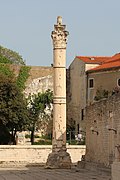Croatian art
| Part ofa serieson the |
| Culture of Croatia |
|---|
 |
| People |
| Mythology |
| Sport |
Croatian artdescribes thevisual artsinCroatia,and art by Croatian artists from prehistoric times to the present. InEarly Middle Ages,Croatia was an important centre forartand architecture in south eastern Europe. There were many Croatian artists during theMedievalperiod, and the arts flourished during theRenaissance.Later styles in Croatia includedBaroqueandRococo.
Ancient heritage
[edit]Prehistoric art
[edit]TheNeolithicinhabitants of the Adriatic Coast and those on thePannonianplain, developed their cultures within the boundaries of present-dayCroatia.The Neolithic is marked by the production ofceramicsandsculptureswith human and animal themes presented as symbolic art. In contrast to the cave paintings of thepalaeolithicage, in the more settled agricultural age, pottery became the main art form, with stylised forms and was primarily ornamental in character. Neolithic artists did not merely imitate or reproduce, but created new forms by inscribing geometrical patterns and decorations.[1]

- Starčevo culture(aPannonian plainculture) had characteristically fine red and ochre ceramics.[verification needed]
- Istrian culture(named after theIstrian peninsula) whose characteristic stone houses (Bunja) built using only dry-stone construction (suhozid).
- Sopot cultureandKorenovo culture(named after the towns ofSopotandKorenovoinSlavonia) with original ceramic pots decorated with flat parallel lines, curves or V-shaped cuts.
- Danilo culture(found onAdriaticcoast and islands) was rich with fine dark ceramics decorated with engraved geometrical motifs, spirals andmeanders.
- Out of this culture developed theHvar culture(after the island ofHvar) that is linked with NeolithicGreekcultures.[1]
There are alsoNeolithicexcavation sites inŠčitarjevonearZagreb,Nakovanjon thePelješacpeninsula and elsewhere.
Copper Age
[edit]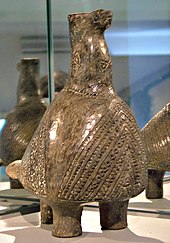
Ceramics of theVučedol culture(named afterVučedolin eastern Slavonia) during the transitionalEneolithicperiod (3500-2300 BC) are of extraordinary quality with black colour, high glow and specific decorative geometrical cuts encrusted with white, red or yellow colours. The influence of metal working techniques can be seen as potters construct with sheets of clay giving distinct edges where surfaces meet and the final pot is burnished for a gleaming look.[1]
Neolithic figurines in moulded clay were stylized versions of human (particularly female) figures, and animals. The distinctiveVučedol Doveis a pot in the shape of a bird, somewhat stylized, with impressed patterning around its body, a double-headed axe (labrys) on its neck and three legs for stability.[1]
Bronze Age
[edit]TheBronze AgeVinkovci culture(named after the city ofVinkovci) is recognizable by its bronzefibulasthat replaced previous objects like bone needles and buttons.

TheBronze cultureof theIllyrians,ethno-tribal groups with distinct cultures, and art forms started to emerge from the cultures of the Copper Age. These Illyrian ethno-tribal areas were found in present-day Croatia, and Bosnia and Hercegovina. From the 7th Century BC,ironreplaced bronze for tools and implements, only jewellery and art objects were still made out of bronze. The CelticHallstatt culturewhich bordered the Balkan region where the Illyrian ethno-tribal groups were living influenced them, but the Illyrian ethno-tribal groups formed their regional centers slightly differently. In the northern Balkan Peninsula, the Illyrian ethno-tribal groups had thecult of the dead,as evidenced from the richness of and care for burial sites, from which burial ceremonies are deduced. These burial sites show a long tradition ofcremationand burial in shallow graves. In the southern Balkan Peninsula, the Illyrian tribes buried their dead under large heaps stone, or earthtumuli(known locally asgromile). The IllyrianJapodestribes had an affinity for decoration with heavy, oversized necklaces made with yellow, blue or white glass paste and they are known for their large ornamented bronzefibulas,[1]spiral bracelets,diadems,andhelmetsmade out of bronze. Small sculptures ofjademade from thearchaicIonianplastic are also found in Japodian tribal areas. Numerous monumental sculptures are preserved, as well as walls of acitadelcalledNezakcijnear present-dayPula,one of the numerous Istrian cities fromIron Age.
Arrival of the Celts
[edit]The 4th century BC saw the firstCeltsarrive into the Illyrian areas of the Balkans; with them they brought the technique of thepottery wheel,new styles of fibulas and different bronze and iron belts, which the local Illyrian tribes had not previously developed. The Celts also mixed with the Illyrian tribal groups in Slavonia, Istria, and Dalmatia.
Antiquity
[edit]Greek colonies
[edit]Greeksailors and merchants from the Greek City States of the south of the Balkan peninsula reached almost every part of Mediterranean including the Adriatic Sea coast of present-day Croatia. Other Greeks came fromSyracuseonSicilyin 390 BC to the islands of Vis (Issa),Hvar(Pharos), andKorčula(Corcyra Nigra) foundingcity-statesamongst the Illyrian ethno-tribal groups. Trading cities were founded on theAdriaticCoast such asTragurion(today calledTrogir),Salona(today calledSolinnear present-daySplit),Epetion(today calledStobreč).[2]

These Greek cities were laid out geometrically and hadvillas,harbours, public buildings, temples and theatres. Pharos and Issa were strong Greek City States that showed their independence with their own coinage and maritime fleets. Unfortunately, besides painted pots and ceramictanagrasculptures, there are few remaining daily living materials from this culture. Two of those are: theCroatian Apoxyomenos,and theBronze head of goddess Artemisfrom the Greek City State of Issa, which dates from the 4th century BC. Another example is astone relief of Kairos(god of joyfulness) from the Greek City-State Tragurion, which dates from the 3rd Century BC, and is associated with the famous Greek sculptorLysippos.[2]
But aside from the superficial contact of trade and warfare, life for the Greek colonists was isolated from the surrounding Illyrian peoples. The Hellenistic culture of the Greek enclaves existed in parallel with the late iron age culture of the wider Illyro-Celtic population. On the mainland the Illyrian ethno-tribal groups were organizing their centers. Illyrian art became influenced by Greek Art, and the Illyrian ethno-tribal groups copied the styles and methods of the Greeks.[2]This can be seen, for example in theDaorstribe of theNeretva Delta.
Roman urbanization
[edit]In the 3rd century BC, theRomanstook over the Greek colonial cities and by the 1st century BC had also subdued the Illyrians, and organized the entire coastal territory by setting up urban cities. Following the conquest, the area became a province of the Roman Empire. Numerous rustic villas, and new urban settlements (the most impressive areVerigeinBrijuni,Pulaand Trogir - formerly Tragurion) demonstrate high level of Romanurbanization.There were at least 30 urban cities acrossIstria,LiburniaandDalmatiawith Roman citizenship (civitas). The best-preserved Roman grid-pattern street layouts (decumanus/cardo) are those inEpetion(Poreč) andJader(Zadar). The best preserved Roman monuments are inPola(Pula); founded in the 1st century dedicated toJulius Caesar,it is full of classicalRoman artsuch as: stonewalls, two city gates, two temples on theForum,and remains of two theatres, as well as theArchfrom the year 30 AD, and the temple of Augustus build in 2-14 AD, and finally the FluvianAmphitheatre(so called – Arena) from the 2nd century.[2]

By the 3rd century AD,Salonawas the largest and most important city of Dalmatia, with 40,000 inhabitants. Nearby, the EmperorDiocletian,who was born in Salona, built his retirement palace (in approx 300 AD), one of the largest and most important monuments of late antique architecture. On its pathways,cellars,domes,mausoleums,arcadesand courtyards can be seen numerous different art influences from the entire Empire. Some of the sculptures are:the head of a boy, girl and a womanfrom Salona,monumental figure of MinervafromVaraždin,the head of HerculesfromSinj,sculptures of Roman emperorsfromNinandVidnearMetković,damaged sculpture of emperorinZagrebMuseum etc.
In the 4th century Salona became the centre ofChristianityfor the entire westernBalkans.It had numerousbasilicasand necropolises, and even two saints:Domnius(Duje) andAnastasius(Staš). One of the few preserved basilicas in western Europe from the time of earlyByzantiumis theEuphrasian BasilicainPorečfrom the 6th century.
The early Middle Ages brought thegreat migration of the Slavsand this period was perhaps aDark Agein the cultural sense until the successful formation of the Slavic states which coexisted with Italic cities that remained on the coast, each of them were modelled likeVenice.
-
Pula, the arena
-
Zadar, Roman column
-
Split, Diocletian's Palace
Medieval Croatian art
[edit]Early Middle Ages
[edit]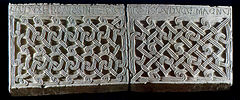
In the 7th century theCroats,with otherSlavsandAvars,came from Eastern Europe to the area of the former Roman provinces of Pannonia, Dalmatia and Istria where they live up to the present day.[3]The Croats were an Iron Age nomadic culture, so avoiding the urban centres they instead settled in the countryside around the Roman cities, for example on an island in the riverJadronear RomanSalona.[4]
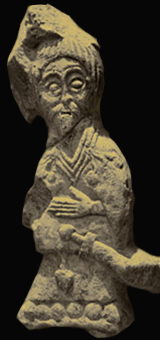
During the 7th and 8th centuries there was a trend of constructing smaller buildings from the material and decorative elements of ruined older Roman buildings. During the 9th century, parallel with the establishment of Croatian principalities, new architecture of pre-Romanesque characteristics emerged. It was based on numerous influences of which the Frankish and Byzantine were the strongest. Gradually those inherited influences evolved into a more original form of architecture.[5] Altarscreens and carved stone windows in those churches were decorated with the shallow interweavingornamentationwhich we callCroatian interlace.In general, the appearance of interlace reliefs in a building indicates a date before 1100.[5]
Motifs of this interlace are often of classical origin (waves, three-string interlace, pentagrams, net of rhomboids etc.), but while in Roman art it was only used as a frame, here it covers the entire surface. The sheer number and quality of these stone monuments indicates a rich masonry tradition with numerous masters and workshops on the east coast of the Adriatic. Croatian interlace was originally painted in bright colours of red, blue and yellow. Since the wall paintings that are mentioned in several literal sources (for example the portraits of the Trpimirović dynasty in the church of St. George in Putalj aboveKaštel Sućurac) are not preserved, they are only type of pre-Romanesque Croatian painting.

Sometimes the interlace was replaced by Biblical figures (as in the altar screen of the Sveta Nedjelja Church in Zadar), but the figures are flattened and depicted with stylized graphic lines. FromCrown Church ofKing Zvonimir(so-calledHollow ChurchinSolin) comes the altar screen with thefigure of the Croatian Kingon the throne withCarolingiancrown, a servant by his side and a bowing subject. Linear cuts representing the folds of the robes are similar to the lines on their faces, and also on those on the frame. Today the board is a part ofSplitcathedralbaptistery.[5]
Out of the crafted objects of the time, manyreliquariesare still preserved.[6]Believed to have magical powers of healing, they were usually shaped for the body part they contained.[7]That is why therelic of Saint James's headin Zadar is shaped like a head; the tube part has section with stream of arcades with single saint in every one, while a dome-like cover is decorated with medallions bearing symbols of evangelist and Christ on the top.
A significant number of churchcodicesfrom this time have survived. InZagrebthere is a Liber psalmorum which was illuminated inBenedictinestyle bypriorMajon for archbishop Paul of Split (c. 1015–1030). In theVaticanthere is a Breviary, also inMonte CassinoBenedictine style (initials of intertwined leaves, interlace and animal heads) which originates from monastery of St. Nicola in Osor. The same style of illumination we can found in Breviars inTrogir,ŠibenikandDubrovnikbut there are many that were recorded (like 47 books in only one church in monastery of St. Peter in Seka) but not preserved.
Romanesque art
[edit]
EarlyRomanesque artappeared in Croatia at the beginning of the 11th century with the introduction ofmonasteriesand churches by theBenedictian orderofMonte Cassino.[8]Two important churches of the time are St Benedict (later St Euphemia) in Split, and St Mary in Zadar, while St. Peter inSupetarska Dragaon the island ofRab(11th century) is the best preserved church of the type in Croatia.[8]
Many cathedrals can be found along the Croatian coast and nearby lands: in Istria, Dalmatia, and Primorje. Cities such asPoreč,Rab,Zadar,TrogirandSplitwere built along the Dalmatian coast with stone houses and large imposing churches with three naves, three apses, columns, arches, arcades and a wooden roof. Cathedrals were built inSenj,Krk,Rab, Zadar, Trogir, Dubrovnik and Zagreb.
In Croatian Romanesque sculpture, there was a move away from interlace to figurative reliefs (for example the reliefs in St Domenica’s in Zadar).[8]
Two outstanding works of Romanesque sculpture date from the first half of the 13th century: the wooden entry doors of theSplit cathedralbyAndrija Buvina(1214) and the main portal ofTrogir cathedraldone byMaster Radovan(c. 1240).

Carved wooden doors from the Romanesque period are relatively rare, as few of them have survived. Buvina’s huge double doors depict the life of Christ in 28 relief panels, each set within a double frame with interwoven vines and scrollwork ornamentation. The scenes are an original design, drawing their inspiration equally from the art of Western miniatures and Eastern Byzantine icons. The carving is precise and clean, leaving each scene easily understood. Also in Split cathedral, the carving on the wooden choir stalls dates to the mid-13th century, with beautiful Romanesque motifs of interwoven vines, figures of saints and a smallbeastiary.An early Gothic feature here is the introduction of a woodcarver at work, possibly a self-portrait.[8]

Although the main portal of Trogir cathedral was not completed until the 14th century, it is clearly Romanesque in form, but with a new Gothichumanisttendency in the carvings.[8]The date for the portal is generally given as 1240, which is when Master Radovan carved his name as part of the latin inscription. The portal has a semi-circulartympanumset within a recessed frame with rounded arches in the Romanesque style. The large main figures are sculptures ofAdam and Eve,borne on lions supported by plinths. Scenes from the life of Christ from theAnnunciationto theResurrectionappear in the arches above the door, with the Nativity occupying the central position of the tympanum, which was unusual for the time. It is a reflection of the spirit of the new Gothic age to replace the dire warning of the Last Judgement above the doorway, with a message of love and hope.[8]

Down both sides of the portal is a sequence of reliefs representing the months of the year. The figures here are particularly animated, and the scenes are taken from contemporary life. For example, December is shown as the month to butcher the pig and make sausages, followed by January where an old man sits by the fireside cooking, while a young man pours wine from an amphora in a reference to Aquarius the water carrier. The realism of such scenes, and the representation of everyday life of the people is a move to Gothic ideas, with its focus on contemporary humanist issues and real characters.[8]
Paintings in Croatia from this time includefrescoes,paintings on wood panels andilluminated manuscripts.The early Romanesque frescoes in St Michael inStondate to the 11th/12th century, and are related to the Benedictine Abbey of St Michael onMonte Gargano.Sadly only fragments of the Ston frescoes still survive, a series of biblical figures, portrayed full-face, dressed in richly ornamented robes. In typical early Romanesque style, the figures are static, described with lines, without much depth or form in the background.[9]The Zadar Benedictine church has 12th century frescoes in a similar style, but not so brightly coloured and less linear. Meanwhile in Istria, there are different fresco styles and influences to be seen from the 12th century. The westernOttonianstyle of art (St Michael int Kloštar atLim Bay), ByzantineComnenianstyle from theAquileiaworkshop (St Jerome’s church in Hum), and a combination of both western and Byzantine styles (St. Foška at Batvači nearPeroj).[10]
Paintings of the time on wood were generally icons of the Virgin Mary with Child or of the Crucifixion. There are six surviving RomanesqueVirgin with Childicons in Croatia, the oldest of which is the Madonna from Saint Sylvester’s Church on the island ofBiševo(1220), now inHvar Cathedral[11]The figures of mother and child are Byzantine in style, combined with a typical Romanesque use of line and colour. Two painted crucifixes from the Franciscan Abbey in Zadar are even older, as are some early Romanesque crucifixes from Istrian churches.[8]
Although the oldestilluminated miniaturein Croatia dates from the 8th century,[12]they are extremely rare until the 11th century. Examples from around that time include the ŠibenikSacramentaryandEvangelistarywritten inCarolingian minuscule,and fragments of a Evangelistary from Rab written inBeneventana.The illuminations in these manuscripts are just simple initials with scrolls and animal heads, but by the 13th century, manuscripts from Trogir, Split and Zagreb contain much more complex illustrations, including entire Biblical scenes taking up most of a page.[8]
Gothic art
[edit]
Gothicart in the 14th century was supported by a culture of city councils, religious orders (such as theFranciscans), and the nobility. It was the golden age of free Dalmatian cities that were trading with Croatian feudal nobility in the continent. Urban organization and evolution of Dalmatian cities can be followed through the continued development and expansion ofRabandTrogir,the regulation of streets inDubrovnik,and the integration ofSplit.
At the end of the 15th century, the majority of the coastal region was administered by Venice, and churches,palaces,cloisters,loggias,clock towers and fountains began to appear, which were influenced by Venetian Gothic: not just in structure and construction, but on the emphasis of decorative elements. The master of the Gothic style wasJuraj Dalmatinac(George of Dalmatia), builder ofŠibenik Cathedral.[13]The form and the decorative elements of the Cathedral, such as a remarkable frieze decorated with 71 sculptured faces of men, women, and children, illustrates the successful fusion of Gothic and Renaissance art.[14]The cathedral also shows the considerable interchange of art and architecture knowledge between Northern Italy, Dalmatia and Tuscany in the 15th and 16th centuries.[14]Juraj Dalmatinac also worked in Split (Chapel ofSt. Anastasiusin theCathedral), Dubrovnik, Zadar andAncona,while his followers spread theVenetian Gothicstyle throughout the whole of Dalmatia.

TheFranciscan friary, Dubrovnikwas built by Mihoje Brajkov of Bar in 1360. Much of the original building was destroyed in theearthquake of 1667,but the cloisters and the carved church portal remain. The lower cloister was built in Romanesque/Gothic style where the capitals are constructed in Romanesque form, but the carvings on them are lively creatures modelled with a Gothic realism.[15]The portal was sculpted in 1498 in Gothic style by the workshop of the brothers Leonard and Petar Petroviċ. The almost life-sized Pietà in the central lunette is flanked by the figures of St. Jerome (holding a model of the pre-earthquake church) and St. John the Baptist. On top of the lunette stands the figure of the Father Creator. Also in Dubrovnik, the oldRector’s Palace(1435) was built in Gothic style by Onofrio della Cava, who was also responsible for two fountains, which are still in use today.[13]

TheChurch of St Mark in Zagrebwas radically reconstructed in the second half of the 14th century in Late Gothic style. The main portal contains a series of carved figures of St Mark, Christ, Madonna and the twelve apostles. On top are the statues of Joseph and Mary with the infant Jesus, and below them stand St. Mark and the Lion. The twelve Apostles are placed on both sides of the portal (four wooden statues have replaced original ones which were destroyed). Originally the entire portal was painted in vivid colours. The portal is considered to be the work of sculptors of the Parler family from Prague (end of the 14th century).[15]

One of the most outstanding works of art from the 14th century in Dalmatia is the large silver chest made for the relics ofSt Simeon in Zadar(1377-1380), with a portrait of the saint himself on the lid. The chest is covered with relief scenes, of which only one (the Presentation in the Temple) is biblical. The St Simeon reliquary crosses the boundary between the western Gothic style and Byzantine.[15]
Some outstanding Gothic frescoes are still preserved in churches across Istria. The small cemetery church of St. Nicholas in Rakotule contains some early examples of Venetian origin.[15]Scenes fromSt Nicholas’ life are depicted in a range of colours and shades, using firm strokes to denote character and volume. The figures are active, and their faces have distinctive features, while details of the background are clearly taken from contemporary life.[16]

Possibly the best-known series of late Gothic frescoes in Istria is in the Church of St Mary on the Rocks (Sv Marija na Škriljinah) near Beram, dating from 1474. Painted by Vincent of Kastav, the frescoes cover the entire interior of the church in a series of 46 panels. The largest composition (8m long) is TheAdoration of the Magi,high on the northern wall. The figures appear three-dimensional, within the illusion of space. Across the back wall, the cycle of life panels conclude with theDanse Macabre(Dance of Death), in which everyone meets their fate - rich or poor, all must die in the end. Scenes of this typically gothic humanist theme were painted in many places across Europe at the time, although not all have survived to this extent. The frescoes of St Marys in Beram remain largely as originally painted, and are amongst the finest works of medieval art in Istria[17]

A series of paintings of exceptional quality on wood are reliably attributed toPaolo Venezianoone of the best-known painters in the Venetian Republic. His work brings a Gothic element toByzantine iconography,using long elegant figures and subtle colours in his signature style. His works in Croatia includepolyptychs(composite altarpieces), paintings in Zadar and Trogir, and the large Crucifixion in the Dominican church in Dubrovnik, which includes separate panels for the Virgin Mary and St John.[15]
One distinctive feature of paintings by local artists from coastal Croatia is a red background in place of the costlier gold. The red brings an appropriate warmth to the Gothic style paintings, as the gold would also have had a red under-painting. One such example is the Crucifixion in the monastery church at Tkon (island of Pašman).[15] There were two trends for paintings on wood in Croatia during the 14th century: one continued with strict linearity to depict volume, while the other used colour to create a more subtle form. In the painting “Mother of God with Child and Donor” in Zadar, the donor himself is shown. As in other European icons of the time, the donor is small. This is an early representation of secular human figures in a religious painting. Such figures were to increase in size, until the human figures achieved their own importance in the Renaissance portrait of the 15th century.[15]Zadar was an important centre for Gothic culture (and painting in particular), which emanated and spread to other Dalmatian communities.[18]

From that time come the two of the best and most finely decoratedilluminatedliturgiesdone by monks from Split, –Hvals' Zbornik(today in Zagreb), andHrvoje's Missal(now inIstanbul). The Missal was written in Split by the residentcalligrapherand glagolitic scribe, Butko, in 1404 forHrvoje Vukčić Hrvatinić,Ban(Viceroy) of Bosnia and Duke of Split. The miniatures are believed to have been painted by a local artist and were done around 1407 in Split, as contemporary events and scenery have been incorporated into the illustrations. Amidst the biblical scenes and allegories are two full-sheet paintings with a non-religious subject – the Duke himself as a chivalric knight on horseback, and his coat of arms. Hrvoje's Missal is an important document both for the Glagolithic script and for the introduction of portraiture into what is essentially a religious book.[15]
Renaissance
[edit]The Renaissance period of art and architecture in Croatia can be said to begin in 1441, when Juraj Dalmatinac was contracted to work onŠibenik Cathedral,and continued to the end of the 16th century.[19]At the time, much of the Croatian coast was administered by theVenetian Republic,and there was a thriving interchange of ideas and skills between Italy and the eastern Adriatic, particularly Dalmatia. As the interior of Croatia came under Austrian Hapsburg rule, and increasingly suffered invasion by theOttomans,the focus was more on fortifications, less on artwork. Under these circumstances, theItalian Renaissanceonly flourished in coastal Croatia with significant new religious and public architecture in Dalmatia clearly influenced by the new style, but in an original way. Three important works from that period contributed to further development of theRenaissance:Šibenik Cathedral,the Chapel of Blessed John inTrogir Cathedral,and Sorkočević's villa in Dubrovnik.
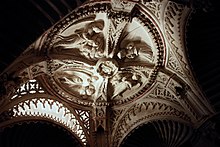
As Juraj Dalmatinac took over responsibility for the building of Šibenik Cathedral, among his first works was in thebaptistry,where he introduced elements inspired byBrunelleschiandDonatello.The soft modelling on the carved figures and the flowing movement are clearly Renaissance, as are the proportions of the baptistry itself. The reliefs on the ceiling show God the Father with a very Renaissance laurel wreath, surrounded by angels and seraphim, and an infant being baptized by a priest. This substitution of human figures in place of Christ and John the Baptist in the Jordan is a reflection of the new humanist trend.[19]These elements are creatively combined with Gothic features for a harmonious overall effect. As mentioned in the previous section, Juraj Dalmatinac is considered a master of blending Gothic with Renaissance.[14]His successors on the Šibenik project wereAndrija Aleši,one of his students, andNikola Firentinac,who was responsible for completing the cathedral according to Juraj’s original plans.
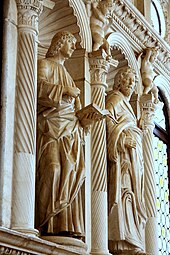
In 1468, construction began on the expansion of the Chapel of the BlessedJohn of TrogirinTrogir Cathedral.The three principal sculptors were Nikola Firentinac, Andrija Aleši andIvan Duknović.The chapel has a barrel vault with God and angels’ faces, below which is a row of circular windows and three tiers of carved figures surrounding the shrine. The quality of the sculptures of Christ, Mary and the apostles in their individual niches, with reliefs of playfulputtiabove and below make the chapel a memorable example of Renaissance art.[20]Among the finest statues are Duknović'sJohn the Evangelist,and Firentinac’sSt Paul.The Gothic sarcophagus and Baroque angels are a later addition.
Inside the protective walls of theRepublic of Dubrovnik,and on several of the nearby islands, manyRagusannobles built their country retreats, elegant villas set in renaissance gardens. These were not as ornate as theirItalian counterparts,but made good use of the terrain with its seaside location and plentiful supply of stone.[21]A fine example isSorkočević's villaon the island ofLapadnear Dubrovnik. Built in 1521, with an unusual asymmetrical design, the house and garden are preserved in their original form.
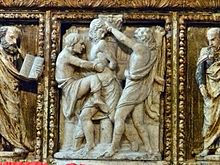
One of the most beautiful Renaissance sculptures in Croatia is perhaps the relief of theFlagellation of Christby Juraj Dalmatinac on the altar of St Anastasius inSplitcathedral. In contrast to the static carving on the altar opposite, three almost naked figures are caught in dynamic movement.[20][22]
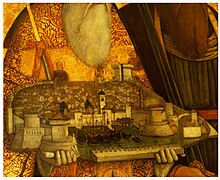
During the 15th and 16th centuries, art flourished in Dubrovnik’s religious institutions, public buildings and its many patrician residences. Although a great deal of the work was commissioned from well-known artists from Italy, much of it was done by locally-born artists. The preferred style of church paintings in Dubrovnik, even into the renaissance period, was still framed in the form of atriptych,orpolyptych.[23]But within that structure, new ideas and designs were introduced, such as portraits depicting real characters,linear perspective,and even some still lifes.[19]The artists of the Dubrovnik Painting School, such asNikola Božidarević,[24][25]Lovro Dobričevićand his sonVicko Lovrin,Mihajlo Hamzić,Blaž Jurijev TrogiraninandIvan Ugrinović,began a tradition of art in the city that continues to the present.[13]Sadly, much of Dubrovnik’s beautiful Romanesque and Renaissance artwork was destroyed in the earthquake of 1667 and the resulting fires, and most of it we know only from documents in the Dubrovnik State Archives.
One Croatian artist who worked mainly in northern Italy wasGiorgio Schiavone(orJuraj Ćulinović), who was born inSkradinin Dalmatia and went on to work withFrancesco SquarcioneinPadua.Today, his paintings are held by several prestigious galleries worldwide, and he is considered the most important Croatian painter of the 15th century.[26][22]Other famous Croatian-born Renaissance artists that lived and worked abroad, were the Laurana brothers,Francesco(Franjo Vranjanin) andLuciano(Luka Vranjanin), the miniaturistGiulio Clovio(Juraj Klović), engraver and portrait painterMartin Rota(Martin Kalunić-Rota) andmannerist painterAndrea Schiavone(Andrija Medulić).
-
Giorgio Schiavone: Saint Jerome
-
Francesco Laurana - Female bust
-
Giulio Clovio - Farnese Hours
-
Martin Rota - Battle of Lepanto
-
Andrea Schiavone - Diana and Actaeon
Baroque and Rococo
[edit]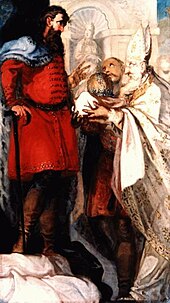
Going into the 17th century, there was a shift of artistic activity away from the coastal region towards inland, continental Croatia. As part of theVenetian Republic,Dalmatia began to rely increasingly on importing art and artists from Italy, particularly Rome and Venice. Meanwhile as the invadingOttomanswere pushed back, the north would gradually emerge from a century of war, to improve fortifications, rebuild devastated towns, and enjoy a revival of the arts.[27]
There were few Croatian artists and architects producing high quality work during the period. Between the slow recovery of the inland population after the war, and the preference in the coastal regions to employ foreign artists and sculptors, it was mainly Italians, Austrian and Slovenes who created and decorated the many Baroque buildings in Croatia.[27]There was a significant increase in the commissioning of large baroque altars in multi-coloured marble with ornate carving. These were mainly imported from Italy, and replaced the existing stone or wood altars.
The ornate Baroque style originated in Rome as a reaction to the counter-reformation in northern Europe, and the Jesuits played a major role in introducing it to Croatia.[27]Large imposing churches were built in numerous places across the country, with accompanying colleges. The most important sites were in Zagreb, Rijeka, and Dubrovnik.

St. Catherine's Church, Zagrebis one of the most outstanding examples of Baroque Jesuit architecture in northern Croatia, with its elaborate interior decoration.[28]Completed in 1632, it was renovated in the 18th century following a major fire. The ornate stucco ceiling is by Anton Joseph Quadrio (1721), with frescoes of the heavens byGiulio Quaglio the Younger.Behind the altar is a largetrompe l’oeilfresco by Krištof Andrej Jelovšek (1762). The six side chapels have two altars each, the finest by sculptorFrancesco Robba.[27]
The biggest Baroque project was the rebuilding of renaissanceDubrovnikafter the catastrophicearthquake of 1667when almost the entire city was destroyed. Many of its churches and public buildings were constructed from the ground up in the new Baroque style, for example the new cathedral, the Jesuit college with the church ofSt Ignatius,and the church of St Vlaho on the main square (1715) which shaped the southeastern section of the city.Pietro Passalaqua[23]united the new baroque areas with hisJesuit Stairway,(reminiscent of the famousSpanish Stepsin Rome) which led to theIvan GundulićSquarebelow.
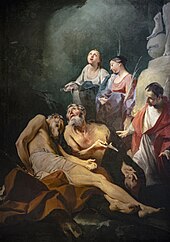
During the Baroque numerous churches were built across Croatia. One of the most beautiful is the church ofMaria of the SnowinBelecfrom 1740 with the entire interior filled with livelygildedwooden sculptures, and frescoes by the painterIvan Rangerfrom Austria. He was a classicRococopainter whose figures were softly painted in graceful positions in cheerful colours.
The most important baroque painter of Dalmatian origin wasFederico Bencovich,[27]who studied underCarlo CignaniinBologna.Other Croatian-born artists of the time include painterBernardo Bobić,who worked mainly in Zagreb and northern Croatia,Matteo Ponzone,who was probably born on the island of Rab,[22]and worked primarily in Italy, andTripo Kokoljaof Kotor who was active in Dalmatia.[27]
The 19th century
[edit]
Two crucial European events shaped the influences on Croatia towards the end of the 18th century. The fall of theVenetian Republicin 1797 was followed by the Napoleonic conquest and formation of the short-livedIllyrian Provincesfrom 1809 to 1814. Afterwards, all of Croatia was ruled by theAustrian Empire,and remained so until theFirst World War.During that time,neoclassicalwas the style for grand buildings, andRomanticismflourished in the arts, with its emphasis on the glories of nature and authenticity of folk art.[29]In the houses of ordinary people, simple decoration and cheerful colours prevailed, andBiedermeierfurniture became popular. Artistic life within Croatia was now focused on Zagreb, with strong connections toVienneseculture andCentral Europe.It was not until much later in the century that Croatian artists began to go wider afield to study — to Munich, Prague and Paris.

At the same time, the cities of Croatia got an important urban makeover. For size and importance, the urban redesign of Zagreb's centre (largely the work ofMilan Lenuzzio,1860–1880) was revolutionary. Between the longest street,Ilica,and the new railway, streets were laid out in a grid pattern with large public and social buildings, such as theneo-RenaissanceCroatian Academy of Sciences and Arts(F. Scmidt, 1884), the neo-baroqueCroatian National Theatre(H. Helmer and F. Fellner, 1895), and the very modernArt Pavilion(1898) with montage construction of steel and glass – Croatian "Crystal Palace",and finally the masterpiece ofArt Nouveau–The National Library(Lubinski, finished in 1912). This urban plan is bounded by series of parks andparkwaysdecorated with numerous fountains, sculptures, avenues and gardens (known as the "Green Horseshoe").
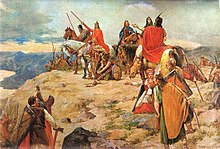
The building that emphasizes all three visual arts is the former Ministry ofWorship and Education,now the Croatian Institute of History in Zagreb (Hermann Bollé,1895). Along with rooms in Pompeii style and renaissance cabinet, the large neo-baroque"Golden Hall"contains historic paintings byBela Čikoš-Sesija(TheBaptism of Croats and Split Council),Oton Iveković(Meeting of Koloman and Croatian Nobility),Mato Celestin Medović(The Arrival of Croats),Vlaho Bukovac(Franz Josephin Zagreb) and decorated with reliefs byRobert Frangeš-Mihanović."The Golden Hall" became a unified monument to its time, one of few in Europe.

Realismappeared in the bourgeois portraits byVjekoslav Karas.[29]The characters of his portraits are true expressions of their time. Realistic landscapes are linked to certain parts of the country – Slavonian forests by artists ofOsijekschool, Dubrovnik in works ofCelestin Medović,and Dalmatian coast in works ofMenci Klement Crnčić.
In sculpture the hard realism (naturalism) ofIvan Rendićwas replaced byArt Nouveaucomposed and moving reliefs byRobert Frangeš-Mihanović.Slava Raškajis particularly notable for her watercolours.
Vlaho Bukovacbrought the spirit ofImpressionismfrom Paris, and he strongly influenced the young artists (including the authors of "Golden Hall" ). Right after he painted the screen in HNK in Zagreb with the theme ofCroatian Illyrian Movement,and symbolic portraits of Croatian Writers in National Library, he foundedThe Society of Croatian Artists(1897), the so-called "Zagreb's colorful school". With this society theCroatian Modern Artstarted. On theMillennium ExhibitioninBudapestthey were able to set aside all other artistic options inAustria-Hungary.
The 20th century
[edit]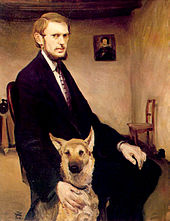
Modern art in Croatia began with thesecessionistideas spreading fromViennaandMunich,andPost-Impressionismfrom Paris.[30]TheMunich Circleused values to create volume in their paintings, in a style much simplified from more detailed earlier, academic style.[31]TheMedulic Societyofsculptorsand painters fromSplitbrought themes of national history and legends to their art,[32]and some of the artwork following the First World War contained a strong political message against the rulingAustro-Hungarianstate. TheZagreb Spring Salonprovided an annual showcase of the local art scene, and a big change was noticeable in 1919 with a move to flatter forms, and signs ofCubismandexpressionismwere evident.[33]Theavant-gardeZenit Groupof the 1920s pushed for integrating the new art forms with the native cultural identity.[34]At the same time, theEarth Groupsought to reflect reality and social issues in their art,[33]a movement that also saw the development ofnaive art.[35]The 1930s saw a return to more simple, classical styles.[33]
Following the Second World War, artists everywhere were searching for meaning and identity, leading toabstract expressionismin the U.S. and artinformelin Europe.[36]In the new Yugoslavia, the communistsocial realismstyle never took hold, butExat 51showed the way withgeometric abstractionin paintings and simplified spaces in architecture.[33]
In the 1950s,Antun Motika,one of the most celebrated modern Croatian artists together withIvan Meštrović,generated a strong reaction from the critics with his exhibition of drawingsArchaic Surrealism(Arhajski nadrealizam).[37]The exhibition had a lasting effect on Croatian art circles,[38]and is generally considered to be the boldest rejection of the dogmatic frameworks of socialist realism in Croatia.[37]
TheGorgona Groupof the 1960s advocated non-conventional forms of visual expression, published their own anti-magazine, and were preoccupied by the absurd.[39]At the same time, theNew Tendenciesseries of exhibits held in conjunction with meetings displayed a more analytical approach to art,[40]and a move towardsNew Media,such as photography, video, computer art, performance art and installations, focused more on the artists' process.[41]TheBiafra Groupof the 1970s wasfigurativeandexpressionist,engaging their audience directly.[36]By the 1980s, theNew Imagemovement brought a return to more traditional painting and images.[36]
See also
[edit]- Croatian Architecture
- List of Croatian sculptors
- History of Croatia
- Croatian literature
- Theatre in Croatia
- Music of Croatia
- Category:World Heritage Sites in Croatia
References
[edit]- ^abcdeRadovan Ivančević (ed.)."Traces of Prehistoric Communities".culturenet.hr web portal to Croatian culture.Ministry of Culture of the Republic of Croatia.Retrieved25 March2021.
- ^abcdRadovan Ivančević (ed.)."Antiquity: Greek colonization of the Eastern Adriatic (4th to 2nd centuries BC); Roman Urbanisation (2nd century BC to 5th century)".culturenet.hr web portal to Croatian culture.Ministry of Culture of the Republic of Croatia.Retrieved25 March2021.
- ^Sedov, Valentin V. (1995)."Slavs in the Early Middle Ages".Rastko.org.rs.Project Rastko. Archived fromthe originalon 11 November 2013.Retrieved25 March2010.
- ^Holcomb, Melanie."Barbarians and Romans".Metmuseum.org.Metropolitan Museum of Art.Retrieved25 March2010.
- ^abcRadovan Ivančević (ed.)."The First Croatian State (Pre-romanesque (9th to 11th centuries)".culturenet.hr web portal to Croatian culture.Ministry of Culture of the Republic of Croatia.Retrieved25 March2021.
- ^Drake Boehm, Barbara."Relics and Reliquaries in Medieval Christianity".Metmuseum.org.Metropolitan Museum of Art.Retrieved25 March2010.
- ^"CATHOLIC ENCYCLOPEDIA: Reliquaries".Newadvent.org. 1911.Retrieved25 March2010.
- ^abcdefghiRadovan Ivančević (ed.)."The Renewal of Towns and Raising of Monasteries: Romanesque (11th and 12th centuries)".culturenet.hr web portal to Croatian culture.Ministry of Culture of the Republic of Croatia.Retrieved25 March2021.
- ^Goss, Vladimir P (1987).Early Croatian Architecture: A study of the Pre-Romanesque(PDF).Gerald Duckworth & Co. Ltd, London.ISBN0-7156-21491.Retrieved2 April2021.
{{cite book}}:|website=ignored (help) - ^Željko Bistrović (2009)."Pre-Romanesque and Romanesque Wall Paintings in Istria".ResearchGate.Istria County Conservation Department in Pula.Retrieved2 April2021.
- ^"Geotrail Biševo: Saint Sylvester's Church".Geopark Vis Archipelago.Retrieved3 April2021.
One of the oldest paintings of Madonna in Croatia, the work of the proto-Venetian painting style from the 13th century (dated 1220), was preserved in this church on Biševo
- ^Galović, Tomislav (2017)."Evangeliarium Spalatense / Splitski evangelijar – najstarija i najsvetija knjiga u Hrvata (tematski uvodnik)".Hrvatska revija(in Croatian). No. 4.Matica hrvatska.Retrieved4 February2020.
- ^abc"Cultural Heritage: Croatian Art History".Republic of Croatia Ministry of Foreign and European Affairs.Retrieved3 April2021.
- ^abc"UNESCO World Heritage List: The Cathedral of St James in Šibenik".UNESCO United Nations Educational, Scientific and Cultural Organization.2000.Retrieved6 April2021.
The structural characteristics of the Cathedral of St James in Šibenik make it a unique and outstanding building in which Gothic and Renaissance forms have been successfully blended
- ^abcdefghRadovan Ivančević (ed.)."The Age of Free Cities, Nobility and Preaching Orders: Gothic (13th and 14th centuries)".culturenet.hr web portal to Croatian culture.Ministry of Culture of the Republic of Croatia.Retrieved25 March2021.
- ^"The Church of St Nicholas, Rakotule".Istra Culture.Istria Tourist Board.Retrieved5 April2021.
- ^Radovan Ivančević (ed.)."Art: Istria: Beram".culturenet.hr web portal to Croatian culture.Ministry of Culture of the Republic of Croatia.Retrieved7 April2021.
- ^Emil Hilje."Gothic Painting in Zadar".University of Zadar.Retrieved10 April2021.
- ^abcRadovan Ivančević (ed.)."The Divergent Paths of the North and South: Renaissance (15th and 16th centuries)".culturenet.hr web portal to Croatian culture.Ministry of Culture of the Republic of Croatia.Retrieved25 March2021.
- ^abEkserd gian, David (2009). "The Renaissance in Croatia and Italy: The Chapel of the Blessed Giovanni Orsini".Croatia: Aspects of Art, Architecture and Cultural Heritage.Frances Lincoln Ltd, London. p. 98.ISBN978-0-7112-2921-1.
- ^Mladen Obad Šćitaroci (1996)."The Renaissance Gardens of the Dubrovnik area, Croatia"(PDF).The Journal of the Garden History Society.24(2): 184–200.doi:10.2307/1587136.JSTOR1587136.Retrieved19 April2021.
- ^abcClifford, Timothy (2009). "Italy and Dalmatia: Architecture, Sculpture, Painting & the Decorative Arts, c. 1400-1800".Croatia: Aspects of Art, Architecture and Cultural Heritage.London: Frances Lincoln Ltd. p. 120.ISBN978-0-7112-2921-1.
- ^abClifford, Timothy (2009). "Dubrovnik: Italian Art, c. 1400-1800".Croatia: Aspects of Art, Architecture and Cultural Heritage.Frances Lincoln Ltd, London. p. 120.ISBN978-0-7112-2921-1.
- ^Belamarić, Joško (2009). "Nikola Božidarević".Croatia: Aspects of Art, Architecture and Cultural Heritage.Frances Lincoln Ltd, London. p. 108.ISBN978-0-7112-2921-1.
- ^"Nikola Božidarević - Great Painter of the Renaissance in Dubrovnik".Dubrovnik Museums.Retrieved27 April2021.
- ^Keith Shaw; Theresa Shaw (2003).Schiavone, Giorgio (di Tommaso) [Ćulinović, Juraj].doi:10.1093/gao/9781884446054.article.T076523.ISBN978-1-884446-05-4.Retrieved21 April2021.
{{cite book}}:|website=ignored (help) - ^abcdefRadovan Ivančević (ed.)."The Northern Revival: Baroque and Rococo (17th and 18th centuries)".culturenet.hr web portal to Croatian culture.Ministry of Culture of the Republic of Croatia.Retrieved28 March2021.
- ^Katarina Horvat-Levaj; Doris Baričević; Mirjana Repanić-Braun (2011).Akademska crkva sv. Katarine u Zagrebu[The Academic Church of St. Catherine in Zagreb] (in Croatian). Institut za povijest umjetnost (Institute of Art History), Zagreb. p. 403.ISBN978-953-6106-86-8.
- ^abRadovan Ivančević (ed.)."From Classicism to Symbolism (19 century)".culturenet.hr web portal to Croatian culture.Ministry of Culture of the Republic of Croatia.Retrieved4 May2021.
- ^"Croatian Art History: An Overview".Croatian Ministry of Foreign Affairs and European Integrations. Archived fromthe originalon 7 October 2011.Retrieved20 June2010.
- ^"Munich Circle".Zagreb: Museum of Contemporary Art. Archived fromthe originalon 21 July 2011.Retrieved17 June2010.
- ^"The Early Twentieth Century".Culturenet.Retrieved27 February2011.
- ^abcdDavor Matičević (October 1991)."Identity Despite Discontinuity".International Contemporary Art Network (I-CAN).Retrieved22 June2010.
- ^Subotić, Irina (1990), "Avant-Garde Tendencies in Yugoslavia",Art Journal,49(1): 21–27,doi:10.1080/00043249.1990.10792663,JSTOR777176
- ^Ian Chilvers."The Hlebine School".A Dictionary of Twentieth Century Art.Retrieved22 February2011.
- ^abc"Umjetnost 20. st. u hrvatskoj"[Croatian Art of the 20th Century] (in Croatian). Scribd.Retrieved12 March2011.
- ^ab"Motika, Antun".Croatian Encyclopedia.Archivedfrom the original on 2 February 2021.Retrieved22 January2021.
- ^"Motika, Antun".Istrapedia.Retrieved22 January2021.
- ^"Gorgona Group".Zagreb: Museum of Contemporary Art. Archived fromthe originalon 21 July 2011.Retrieved13 March2011.
- ^"New Tendencies".Zagreb: Museum of Contemporary Art. Archived fromthe originalon 21 July 2011.Retrieved13 March2011.
- ^"New Art Practice".Zagreb: Museum of Contemporary Art. Archived fromthe originalon 21 July 2011.Retrieved13 March2011.
Further reading
[edit]- Pelc, Milan, ed. (2010).Hrvatska umjetnost – povijest i spomenici(PDF)(in Croatian). Zagreb: Institute of Art History.ISBN978-953-6106-79-0.Retrieved20 February2017.


